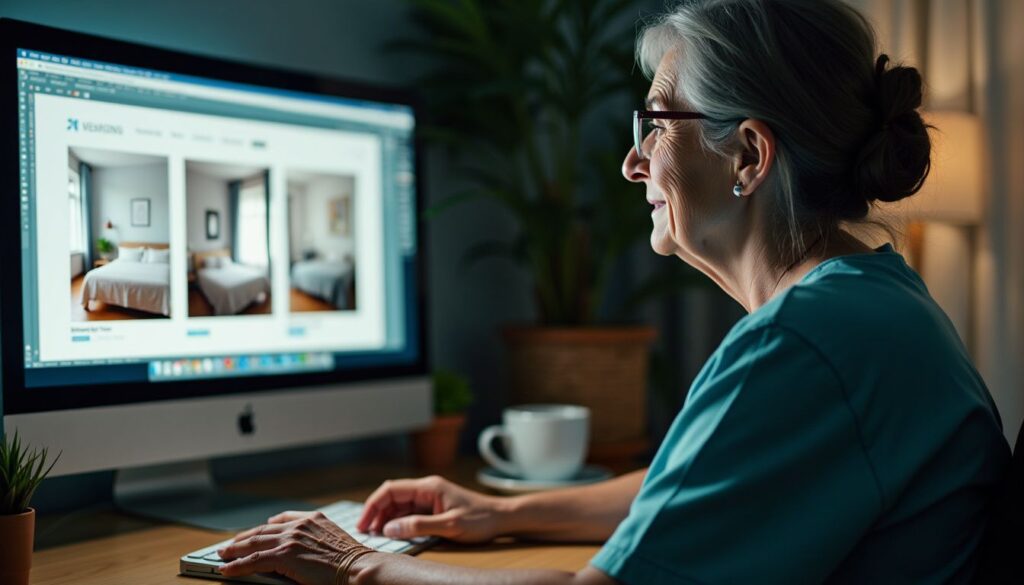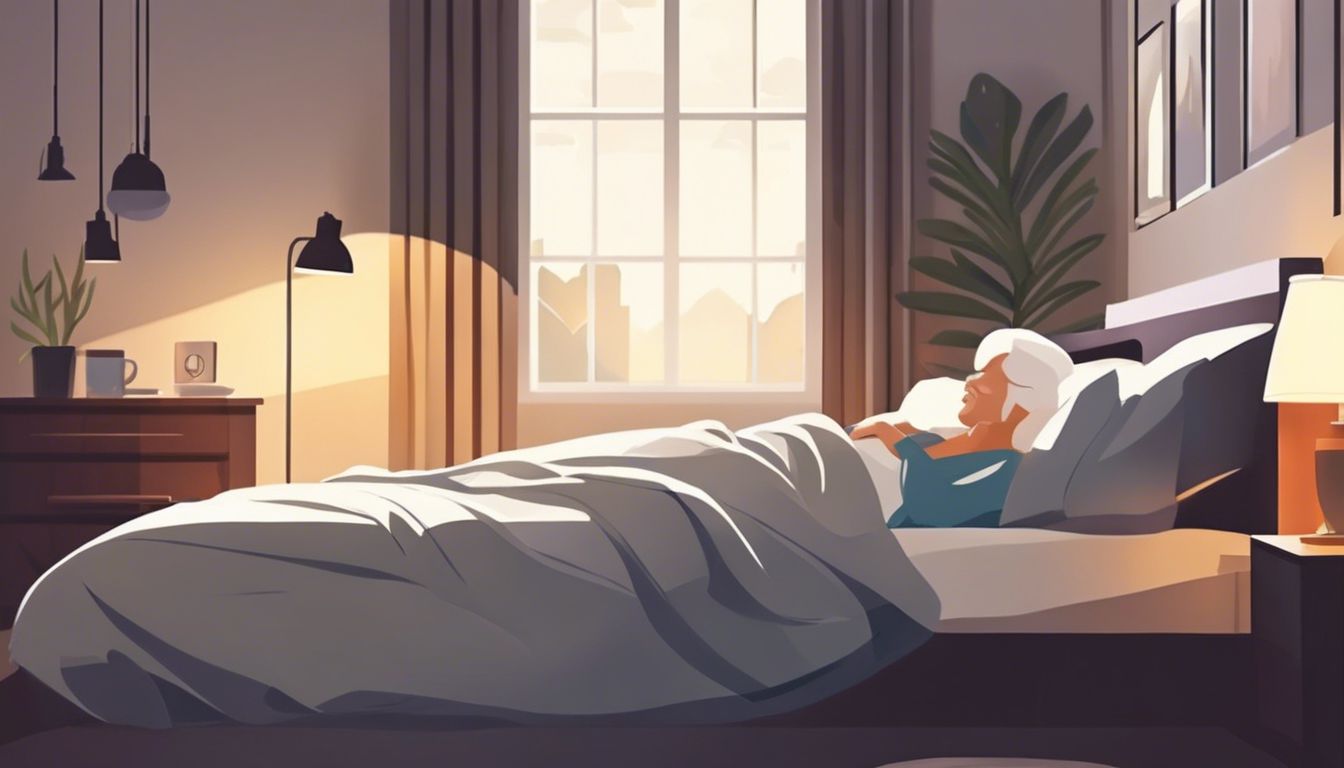Caregivers often struggle with finding the right bedroom design. One fact stands out – 40% of nurses work long shifts, leading to stress. This article guides you in choosing better bedroom designs for caregivers.
Read on for smart choices.
Key Takeaways
- Safety features like electric beds and smart monitors are important for caregivers’ bedrooms. These help in quick care and keeping everyone safe.
- Single-family rooms offer privacy and reduce mistakes with drugs because of smart systems. But, open-bay designs have problems like more walking and risk of germs spreading.
- Design can cut down stress for caregivers. Features like adjustable beds and chairs that prevent back pain make caring easier.
- Tech stuff like health watches helps track patients without waking them up. This means fast help if needed.
- Good design needs to think about how people act in the room. Things like soft lights for night checks or easy reach spots for tools matter a lot.
Key Considerations in Bedroom Designs for Caregivers

In designing bedrooms for caregivers, safety and ease of moving around are top priorities. These spaces must also be a spot where they can relax and recharge after long hours.
Safety Features
Safety features are key for caregivers’ bedrooms. First, we talk about a decentralized medication distribution system. This setup makes sure patients get the right medicine and lowers mistakes by a lot.
Electric beds, call devices, and smart monitors are must-haves too. They make care quick and safe.
Stretchers play a big part during emergencies. They need clear paths to move fast and smoothly. This planning saves crucial time and keeps everyone safer.
Safety first means adding tech that protects both caregiver and patient.
Accessibility
After considering safety features, accessibility takes the stage. This means making sure caregivers can easily reach everything they need fast. Equipment and supplies stay close to patients to cut down on walking time.
Rooms get equipment closets filled with necessary items, so no time is wasted looking for things. This setup helps caregivers do their job better and faster.
Putting support spaces closer also makes work easier for staff. They don’t have to walk far to find what they need, saving energy and time. This design is smart because it helps everyone in the room feel better taken care of, making the bedroom a better place for both caregiver and patient.
Comfort and Ergonomics
Caregivers need chairs and beds that are easy to use. Good design helps them avoid stress and tiredness. Rooms should have plenty of natural light but also ways to control it, like curtains or blinds.
This makes sure caregivers can rest well anytime.
Furniture must fit the room right. It should let caregivers move freely without bumping into things. For example, tables with rounded corners help reduce injury risk if someone bumps into them.
Plus, adjustable beds make it easier for caregivers to help patients safely and comfortably.
Essential Bedroom Items for Caregivers
Caregivers need specific things in their bedrooms to help them do their job well. These items ensure safety, comfort, and efficiency.
- Electric nursing beds: These beds adjust easily. Caregivers can change the bed’s height or position. This helps when caring for patients who need help moving.
- Adjustable bedside brackets: They hold important tools or devices close to the bed. This makes it easy for caregivers to grab what they need quickly.
- Movable tables: These tables slide over a bed or chair. They are great for meals, reading, or holding a laptop.
- Hoists: They lift patients safely from the bed to a wheelchair or another area. This reduces strain on caregivers.
- Transfer mats and boards: These help move patients between surfaces without lifting them directly. It makes transfers smoother and safer.
- Rotating blankets and leg lifters: These assist in turning or moving patients with less effort, helping prevent injuries in caregivers.
These items support caregivers in providing better care while also taking care of their own health and safety. Next, we’ll look into different room designs for caregivers.https://www.youtube.com/watch?v=KpqZ15xU7hY
Comparing Single-Family Room and Open-Bay Designs
Looking at Single-Family Room and Open-Bay Designs, there’s a lot to consider for caregiver spaces. Single rooms give privacy and calm. Open areas may feel less private but can hold more beds.
Both have their ups and downs, from how easy they make it to reach patients to how well caregivers can do their jobs. Want to know which one might be best? Keep reading!
Advantages of Single-Family Rooms
Single-family rooms offer many benefits for both patients and caregivers. These rooms reduce travel distances for staff, making their work easier. They also have multi-use areas. This means one room can support different activities without moving the patient.
These designs improve patient safety too. How? They use smart systems to spread out medication safely. This cuts down on mistakes with drugs and keeps everyone safer.
Single-family rooms are game-changers, offering privacy and safety in ways open-bay designs can’t match.
Challenges of Open-Bay Designs
Open-bay designs lead to more walking. Caregivers spend extra time moving between support spaces. This layout makes it hard to control infections. Germs spread easily in open areas, putting everyone at risk.
Noise is another big problem. It increases stress for patients and caregivers alike.
These designs also make privacy hard to keep. Patients and family members feel less comfortable without walls or rooms separating them. Plus, it’s harder for caregivers to focus on one patient at a time with so many people close by.
Open bays mean less effective care due to these distractions and risks.
Design Features that Enhance Caregiver Efficiency
Designs like easy-to-reach equipment spots and clear room plans make caregiver work faster. Explore more to see how this works in action.
Strategic Location of Equipment Closets
Placing equipment closets in each patient room makes a big difference. It cuts down on how far caregivers must walk to get supplies and medications. This saves time and lets them spend more moments with patients, improving care.
Having what you need close by means faster, better help for those in need.
This setup also helps stop infections since items are not moved from one place to another as much. Keeping things nearby but inside the room reduces the risk of spreading germs.
Enhanced Visibility and Room Layout
After finding the best spot for equipment closets, we need to talk about seeing better and how things are placed in rooms. Good room layout means caregivers can see everything clearly.
This stops mistakes and keeps both patients and nurses safe. For example, making sure beds are in direct view helps with quick reactions when needed.
Rooms should also have a setup that lets caregivers move easily without bumping into things. Multi-use areas cut down on walking back and forth. Everything has its place close by, from medical tools to personal care items for patients.
This design supports fast access during emergencies and daily tasks, making everyone’s job smoother.
Incorporating Technology in Caregiver Bedrooms
Adding tech to caregiver bedrooms boosts care. Think smart beds and health watches. These tools keep track of well-being and make jobs easier. Want to learn more? Keep reading!
Use of Smart Furniture
Smart furniture makes caregiving easier. Electric nursing beds and adjustable bedside brackets help caregivers reach their patients quickly. Movable tables let them adjust the room as needed.
This kind of furniture reduces stress and saves time.
Smart furniture is not just a tool; it’s a caregiver’s partner in providing better care.
Using hoists, caregivers can move patients safely. They prevent injuries for both the patient and caregiver. These items prove that smart design can change healthcare for the better.
Integration of Health Monitoring Systems
Health monitoring systems in bedrooms track vital signs. They alert caregivers to changes. This tech includes intelligent devices and emergency call tools. For example, a device can check heart rate or oxygen levels while a person sleeps.
If something goes wrong, it sends an alert right away. This helps caregivers act fast, keeping patients safe.
These systems use wi-fi and sensors. Caregivers get updates on their phones or computers. They can see information anytime without disturbing the patient’s sleep. It makes caring for someone easier and more effective.
Plus, it reduces stress for both the caregiver and the patient by preventing problems before they become serious.
Ergonomic Design for Caregiver Health
Ergonomic design keeps caregivers healthy by making sure they move in safe ways. This includes beds that adjust and chairs that help prevent stress. These tools make caring easier and safer.
Keep reading to learn how these designs help caregivers every day.
Adjustable Bed Designs
Adjustable bed designs make life easier for both caregivers and those they look after. These beds can move up and down. This helps people get in and out of bed safely. They also come with adjustable bedside brackets for extra support.
Caregivers find these beds helpful because they reduce the risk of injuries. People staying in bed a lot can avoid pressure sores with these designs. Adjustable beds are key in bedrooms where safety, comfort, and ease matter a lot.
Stress-Reducing Features in Furniture
Furniture that helps reduce stress has special features. Chairs and beds can adjust to make sitting or lying down more comfortable. This means less back pain and more rest for caregivers.
Some furniture also uses colors and materials that help calm the mind. For example, soft blues and greens in a chair’s fabric can lower anxiety.
Tables with rounded corners are safer and prevent accidents in tight spaces. Lights built into bed frames softly illuminate the room without harsh glare, making it easier to relax at night.
All these details in furniture design create a peaceful bedroom environment for caregivers, helping them recharge better after long hours of work.
Sensory and Behavioral Considerations in Design
Designs should meet sensory and behavior needs—like light for seeing, quiet areas for less noise, and space that feels good. This makes rooms work better for everyone. Keep reading to find out how.
Tailoring to Sensory Needs
To meet sensory needs, bedrooms for caregivers must focus on light, sound, and air. Good lighting helps keep the mind alert. Natural light is best, but artificial lanterns work when sunlight is not there.
For sound, rooms should have materials that lessen noise. This makes sleeping and resting better for health. Air quality also matters a lot. Windows that open bring fresh air in and help with good breathing.
Caregivers need spaces that make them feel calm and focused. Bedrooms should have green plants to clean the air and add calmness. Colors in the room can affect mood too – soft blues or greens are soothing.
All furniture should be easy to move for cleaning and adjusting space as needed. These steps will make sure caregivers can look after others well while staying healthy themselves.
Accommodating Behavioral Habits
Designing bedrooms for caregivers means thinking about how they move and act. Caregivers do many things like lifting patients, using medical tools, and resting between tasks. Rooms need to make these actions easy.
This includes having space for walking around beds, clear paths to the bathroom, and places to keep personal items close.
For example, if a caregiver needs to check on someone at night without waking them up, smart lighting can help. These lights turn on softly when someone walks by. They also don’t make noise which could disturb sleep.
Plus, placing key items within reach makes it easier for caregivers to work without extra steps.
Smart design supports both the caregiver’s tasks and their rest moments.
Case Studies and Real-World Applications
Real-life examples show how design impacts caregiver well-being and patient feedback. Want to learn more? Keep reading.
Impact of Design on Caregiver Well-being
Design matters a lot for caregiver health. Good design can cut down on mental stress and burnout. A room that’s easy to get around in helps caregivers do their job without getting hurt or too tired.
For example, beds that move up and down make it less hard to care for patients. Rooms with better light and less noise also help caregivers feel better.
67% of nurses say they have more work now than six months ago. 59% feel burned out because of this extra load. But, rooms designed with thought can reduce these problems. Features like smart technology and places to rest during breaks can keep nurses happy at work.
This means fewer mistakes and happier patients too.
Patient and Caregiver Feedback on Different Designs
From 2018 to 2020, a study with 24 bedridden older people and their caregivers gave us clear feedback. Most said rooms with easy access to assistive devices made care easier. They liked designs that let them reach everything without moving much.
This means less stress and more safety for everyone.
Caregivers also preferred bedrooms with good lighting and fresh air systems. This helped keep the room comfortable and healthy. They disliked rooms that were hard to move around in or had poor light and air flow.
Keeping both patient and caregiver happy is key, so these points are very important.
Conclusion
Different bedroom designs matter a lot for caregivers. Rooms need good safety, easy access, and comfort to help them do their jobs well. Smart tech and the right furniture can make things better for both caregivers and those they care for.
Single rooms offer privacy but open bays can be tough because of noise and less control. In the end, choosing smart designs helps everyone feel better and work better too.
FAQs
1. How do different bedroom designs impact caregivers and the elderly?
Different bedroom designs can significantly influence caregivers’ workload and the health of those they care for, including the elderly. Factors such as heating and cooling systems, natural ventilation vs air conditioning units, soundproofing, illumination from artificial lighting or natural sources all play a part.
2. What role does room design play in neonatal intensive care units (NICUs)?
Room design in NICUs is crucial for both neonates born preterm or with low birth weight and healthcare professionals providing nursing care. Aspects like indoor air quality, infection control measures like hand-washing facilities, adequate space for skin-to-skin contact known as kangaroo care are vital.
3. Can room design help reduce medical errors?
Yes! A well-thought-out room design considering factors such as soundscapes to minimize noise-induced stress and fatigue can potentially decrease medical errors including medication mistakes made by overwhelmed family caregiver or hospital staff.
4. Are there any studies on how room design impacts caregiving?
Several cross-sectional and qualitative studies have been conducted exploring this aspect – focusing on elements like tactile comfort of furnishings to larger concerns like transport bottlenecks within healthcare facilities that might affect productivity.
5. Does AI have a role in designing rooms for caregiving?
Artificial intelligence can indeed aid in designing optimal spaces for caregiving – be it an intensive care nursery or a home setup designed for aging in place – by analyzing data from various aspects such as staff turnover rates to patient non-adherence issues.
6. How does COVID-19 pandemic influence bedroom designs for caregivers?
The Covid-19 pandemic has brought new challenges requiring modifications including enhanced infection control measures; creating isolation areas if needed while ensuring mental health support through aspects like visual field enhancements to promote enjoyment despite restrictions.









